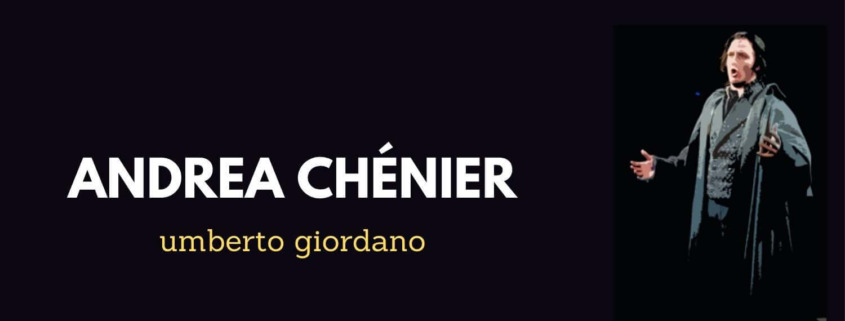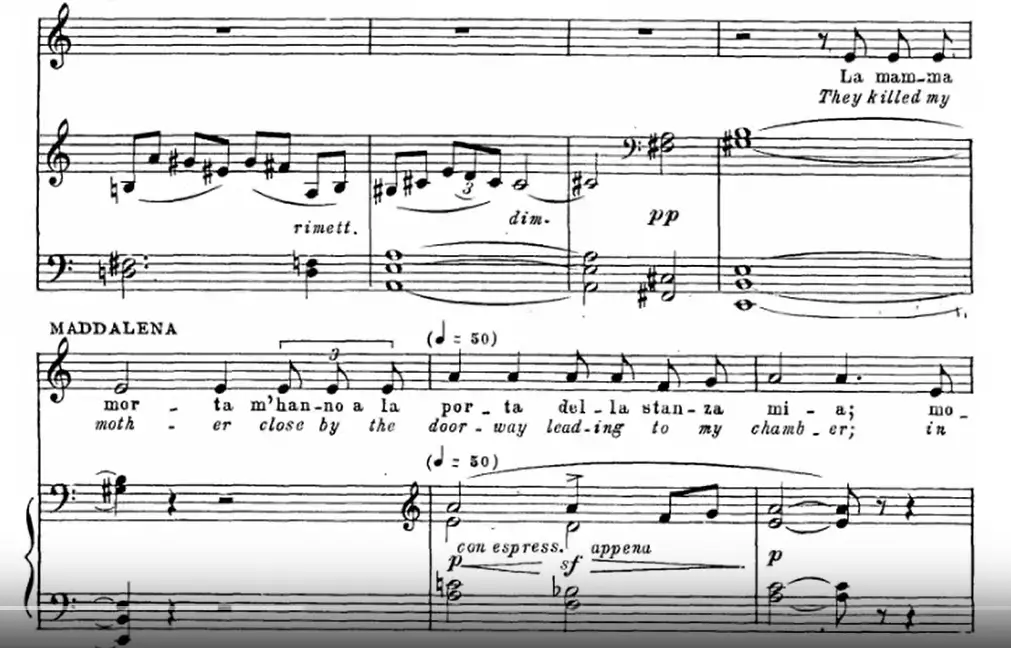LA MAMMA MORTA – an aria from the opera Andrea Chenier
The Portrait of Giordano’s Aria LA MAMMA MORTA
Read Interesting facts and hear great YouTube Videos about the famous Aria “LA MAMMA MORTA”.
If you want to hear more about the opera Andrea Chenier, click on the link to the opera portrait
The aria – synopsis and background
Synopsis: Some months later. Gérard just learned that Chénier got arrested. He hopes that this is the opportunity to get Maddalena. Despite his remorse, he prepares the indictment against Chénier, of whose guilt he is not convinced. Maddalena mourns her family’s fate and begs Gérard to release Chénier. Gerard confesses Maddalena his love and she offers him a night if he releases Chénier.
Maddalena’s aria is made up of two parts. At the beginning it is a bitter accusation of the revolution’s atrocities, and in the second part we hear an extatic love anthem. The interpreter must be able to portray both the drama and the horror as well as the lyricism of love.
The aria begins with a lonely string player playing “con espressione”. Maddalena enters with “la mamma morta”, ten notes whispered at the same pitch, pale and with resignation:
Suddenly and filled with horror, the music accelerates to “quando ad un tratto un livido bagliore guizza e rischiara innanzi a’ passi miei la cupa via! (When suddenly a pale glow flashes and it lightens ahead of me The dark street!) and she sees her family’s burning house in front of her eye. In the pale tremolo of the strings you can hear the crackling of the fire. At the mention of Bersi, warmth flickers on “buona and pura”, shortly afterwards the tone changes again into bitterness, that Bersi had to market her beauty to ensure hers and Maddalena’s survival.
A lonely viola with a painful and comforting motif of four ascending notes leads into the second part. The mood changes within a few bars. Maddalena sings of her love. With a beautiful passage “nei miei occhi” her heart literally opens. Giordano increases the tempo and intensity several times up to “Io sono il dio che sovra il mondo” and reaches its climax with the highest note B on “Ah io son l’amor”. At the end Maddalena falls back into the resignation of the beginning with the horrible “e vi bacia la morte” (and death kisses you).
The Aria – the text of LA MAMMA MORTA
La mamma morta m’hanno
alla porta della stanza mia;
Moriva e mi salvava!
poi a notte alta
io con Bersi errava,
quando ad un tratto
un livido bagliore guizza
e rischiara innanzi a’ passi miei
la cupa via!
Guardo!
Bruciava il loco di mia culla!
Cosi fui sola!
E intorno il nulla!
Fame e miseria!
Il bisogno, il periglio!
Caddi malata,
e Bersi, buona e pura,
di sua bellezza ha fatto un mercato,
un contratto per me!
Porto sventura a chi bene mi vuole!Fu in quel dolore
che a me venne l’amor!
Voce piena d’armonia e dice:
“Vivi ancora! Io son la vita!
Ne’ miei occhi e il tuo cielo!
Tu non sei sola!
Le lacrime tue io le raccolgo!
Io sto sul tuo cammino e ti sorreggo!
Sorridi e spera! Io son l’amore!
Tutto intorno e sangue e fango?
Io son divino! Io son l’oblio!
Io sono il dio che sovra il mondo
scendo da l’empireo, fa della terra
un ciel! Ah!Io son l’amore, io son l’amor, l’amor”
E l’angelo si accosta, bacia,
e vi bacia la morte!
Corpo di moribonda e il corpo mio.
Prendilo dunque.
Io son gia morta cosa!
Written for a «dramatic soprano»
The role of Maddalena is written for a dramatic soprano. The dramatic soprano must have a strong, voluminous voice. The demand for vocal creativity is high, which is why these roles are usually entrusted to vocally mature and experienced singers. The role requires a high resilience and endurance of the singer.
Famous interpretations of LA MAMMA MORTA
Callas’ live recording from 1955 is simply great. It gives each verse its own tone colour and her voice shines clearly from the musical cloud of the orchestra. The beginning is incomparable, once the voice is cutting (un livido bagliore guizza e rischiara innanzi a’ passi miei la cupa via), then her voice is tremoloing before excitement and horror (Bruciava il loco di mia culla!) or pale (Il bisogno, il periglio!). The transition to the second part is heavenly (Voce piena d’armonia e dice: “Vivi ancora! Io son la vita!) and the increase in intensity of the second part is phenomenal. This interpretation captivates the listener and creates a shiver until the bones. No wonder that at the end the applause literally bursts from the audience.
La mamma morta (1) – Callas
If you know the movie “Philadelphia”, you might remember Tom Hanks explaining to Denzel Washington the scene from Andrea Chénier’s “La mamma morta”, it is sung by Maria Callas.
Next you will hear a haunting interpretation from Anna Netrebko. Her voice conveys a dramatic and touching effect. An excellent interpretation.
La mamma morta (2) – Netrebko
A third version by Angela Gheorghiu. The recording captivates with its lyricism and beauty. But she lacks the vocal power of the Callas, so that she cannot reach the drama and intensity of the Callas recording.
La mamma morta (3) – Gheorghiu
As the fourth interpretation we hear Renata Tebaldi, the long-time rival of the Callas. Her recording lacks some expressiveness in the first part. The second part is all the more impressive.
La mamma morta (4) – Tebaldi
Peter Lutz, opera-inside, the online opera guide to the Aria “LA MAMMA MORTA” from the opera Andrea Chénier.




Leave a Reply
Want to join the discussion?Feel free to contribute!